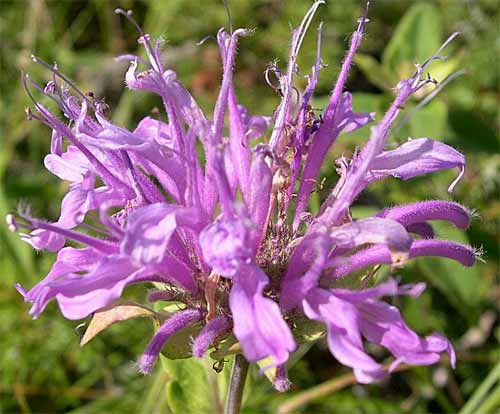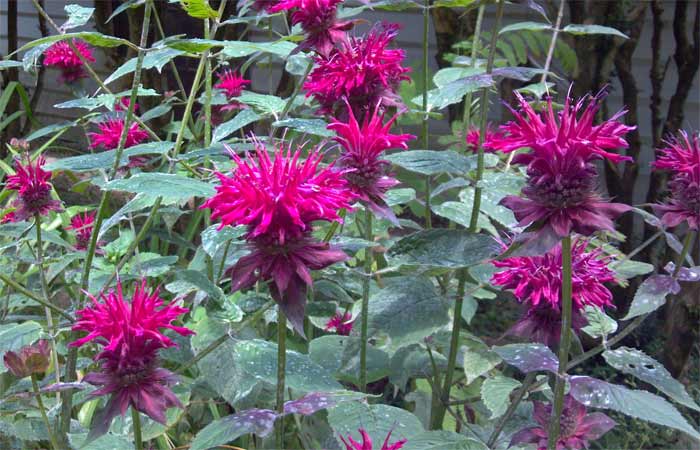Bee balm in herbal medicine
Bee balm (Monarda fistulosa) has beautiful flowers, attracts bees, and makes a lovely herbal tea.
It is known by many names including Sweet Melissa, lemon balm, sweet balm, wild bergamot, and Oswego tea.

Many people in North Georgia grow bee balm in flower beds, never realizing that it makes a relaxing and warming medicine.
Bee balm is a natural remedy for many conditions.
Bee balm is a mild, natural tranquilizer often used to treat sleeping disorders like insomnia naturally.
Bee balm calms the nerves. It is used as a remedy for headache, depression, tension, flatulence, colds, flu, sore throats, hypertension, thyroid conditions (such as Grave’s disease), bronchitis, other lung problems, indigestion, nausea, asthma, cold sores, herpes, mumps, menstrual cramps, and colic.
Sometimes bee balm is used to induce mild sweating and to bring on menstruation.
Bee balm is used in teas, tinctures, poultices, compresses, gargles and other herbal products you can make at home.
Bee balm, a strong antioxidant, contains lots of polyphenols and flavonoids. It is a strong free radical scavenger. This is great news for our cells!
Scientific studies
Studies show that bee balm contains luteolin. Luteolin is found in other healing herbs, and is useful in treating inflammation, nervous conditions, and even cancer.
Bee balm is also one of just a few herbs that contain an abundance of thymoquinone. This substance may be useful in the treatment of pancreatic cancer.
Results from scientific tests indicate that bee balm essential oil has significant pharmacological potential because of the high levels of polyphenols. I am so grateful that bee balm grows here on the farm!
A long history
Bee balm has a long history of treating many chronic diseases especially ones caused by inflammation such as arthritis.
Native to North America, bee balm is cultivated as a landscape plant, but its history as a medicinal herb can't be denied.
Bee Balm was used by the Cherokee people to cure flu, gum disease, and infections. They also used it in poultices to stop headache pain.

Jan's Bee Balm Tincture recipe:
- To make bee balm tincture, harvest clean leaves and flower tops.
- Break or tear the leaves and flowers into small pieces. Do not cut or chop with metal tools.
- Wash, dry in salad spinner or on a towel, and put in a mason jar. Do not pack down too tightly. A gentle touch is always best so "pack gently".
- Cover your bee balm with vodka or any high-proof distilled spirit that can be taken internally. Do not use rubbing alcohol! Fill jar to within an inch of the top.
- Shake or stir gently every day to prevent mold growth on exposed plant material.
- After a week or so, strain through several layers of cheesecloth.
- Store liquid in a jar with a tight fitting lid in a cool location. We store ours in the refrigerator.
- If desired, make double strength tincture by repeating the process with fresh plant material (and the previously infused vodka).
- Of course, tinctures should not be given to children or recovering alcoholics due to alcohol content.
- An average dose of bee balm tincture is one or two teaspoons four or five times a day (until condition is cured).
- Tincture, when made and stored properly, can last up to seven years.
Bee balm fights infection and relieves pain.
Bee balm contains polyphenols that fight harmful bacteria including streptococci.
It also contains an anesthetic compound that relieves pain.
Bee balm makes a great wound compress since it relieves pain, helps stop bleeding, and prevents infection.

Use bee balm as an herbal remedy for gout.
Bee balm compresses can relieve gout and arthritis flare ups. It's easy to make a herbal compress!
- Just simmer fresh leaves a couple of minutes.
- Press out the water for tea, and use the wilted plant material as a compress.
- Apply to whatever area on the body that needs treating.
- As a tea, bee balm relaxes the smooth muscles in the digestive tract which makes it useful for treating bowel disorders.
Bee balm herbal tea
If you are able to harvest a good supply of fresh bee balm, try some of the leaves and flowers in tea or your bath, dry some for winter use (it is very warming), and make tincture with the rest. Fresh and dried bee balm make excellent herbal teas.
- To dry the leaves for winter use, harvest before flowers open and during bloom - in mid summer.
- Dry leaves in an airy location with low humidity to avoid mold.
- Bee balm loses some of its fragrance when dried but retains healing properties and taste for up to a year.
- Combine bee balm with peppermint for upset stomach and with valerian for insomnia or nervous conditions.
Relax in a bee balm bath
Bee balm is wonderful when used in scented pillows, potpourri, and herbal baths. Just put a few whole branches of the herb in your tub while running the water. The spicy scent will relax your mind and your body.

Bee balm is native to North America.
Originating in North America and related to the mints, bee balm produces brightly colored flowers at the top of a tall stalk. The shaggy blooms usually range in color from hot pink and lavender to flaming red and burgundy.
The branching plants grow to a height of four feet and likes rich, fairly moist, well-drained soil with a neutral ph. Bee balm will grow in full sun or partial shade. The plant is a perennial and is easily divided by division.
Bee balm, like mint, can take over a flower bed quickly (it spreads by underground runners). Roots are very shallow so take care when weeding.
Prune almost to the ground in the fall. Bee balm does not grow well where winters are warm and humid. Do not harvest bee balm for medicinal use if leaves develop spots of white mildew.
*Bee Balm may interfere with some thyroid medications. Always consult with a healthcare professional before using any herbal remedies especially if pregnant, nursing, or taking prescription (or over-the-counter) medications.
Sources:
https://www.ncbi.nlm.nih.gov/pmc/articles/PMC8118672/
https://pubmed.ncbi.nlm.nih.gov/35810693/
Blessings to you and yours!
Thanks so much for reading my blog. Jan.

*Note - the information on this website has not been evaluated by the Food and Drug Administration.
© 2005-2024 website design and content by Janice Boling